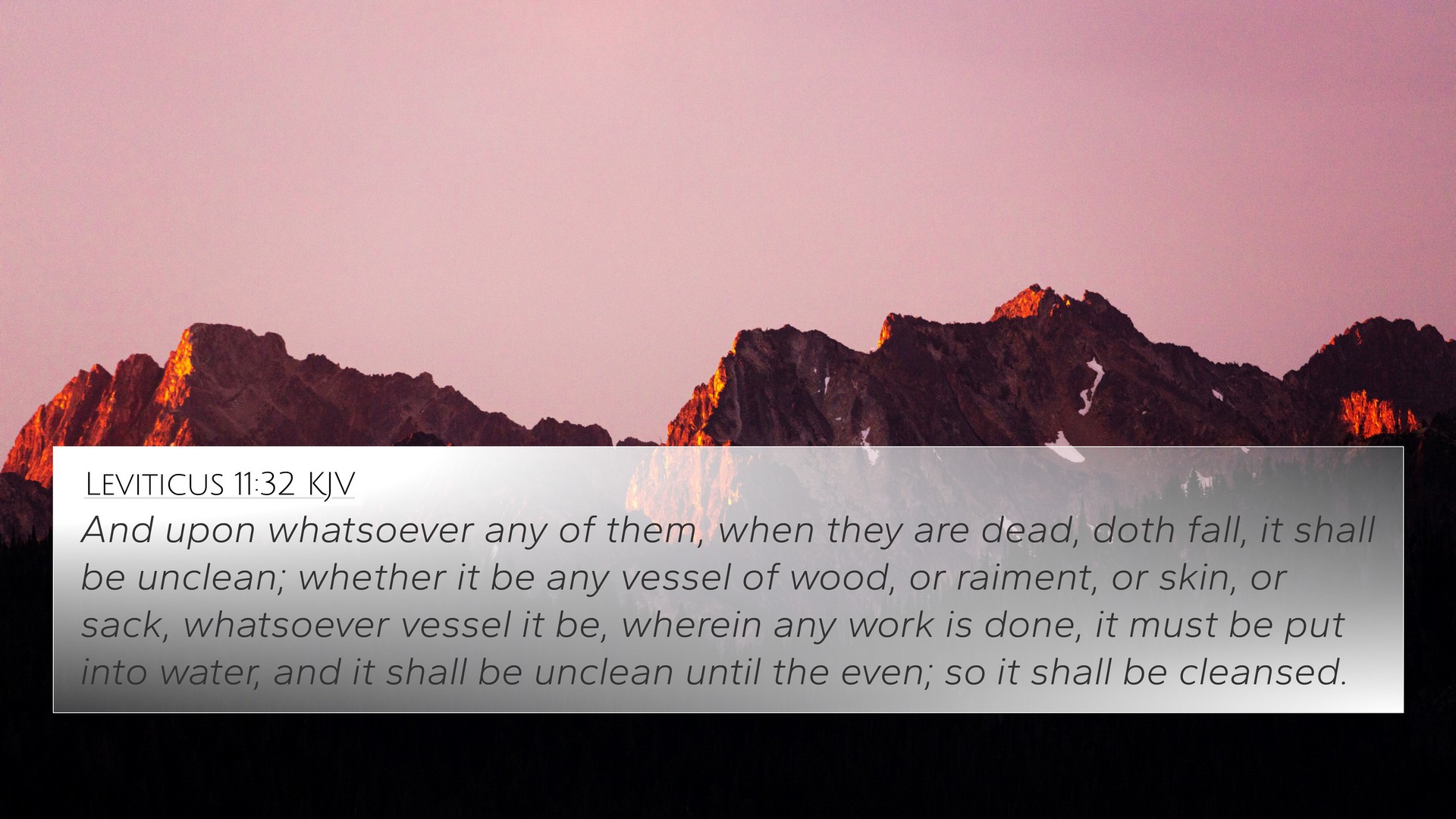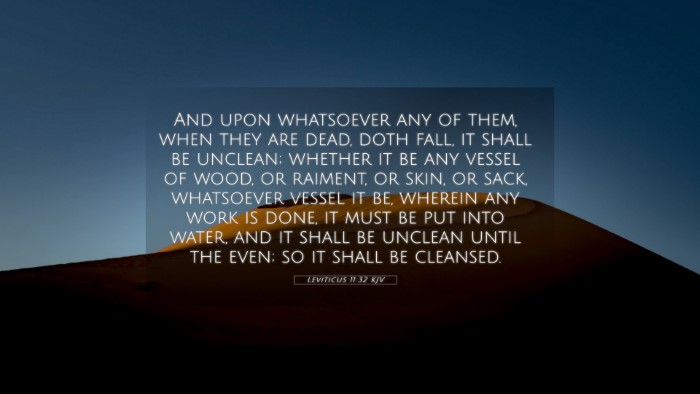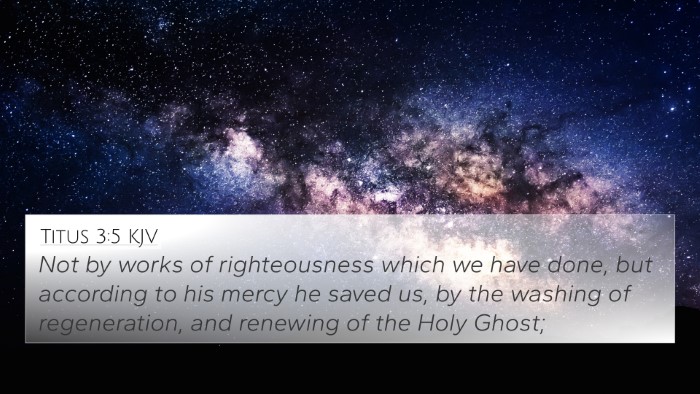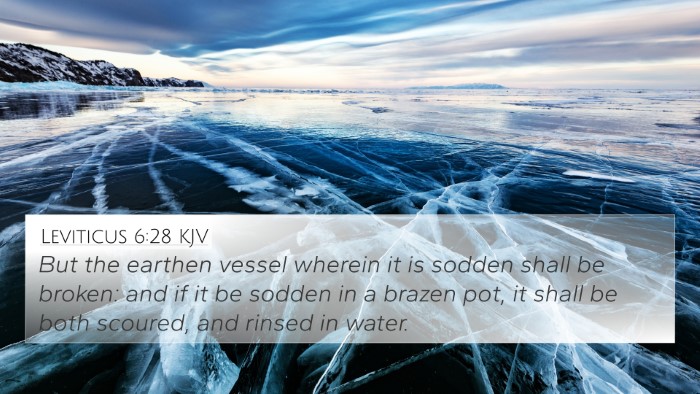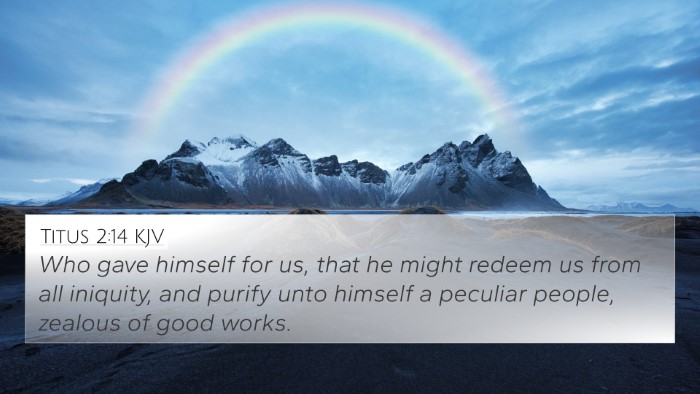Understanding Leviticus 11:32
Leviticus 11:32 states: "And upon whatsoever any of them, when they are dead, doth fall, it shall be unclean; whether it be any vessel of wood, or raiment, or skin, or sack, whatsoever vessel it be, wherein any work is done, it must be put into water, and it shall be unclean until the even; so it shall be cleansed."
Meaning and Interpretation
The context of Leviticus 11:32 is situated within the larger framework of clean and unclean animals, as God provides the Israelites with dietary laws. This verse emphasizes the consequences of coming into contact with carcasses of unclean animals and encapsulates the broader themes of holiness and ritual purity.
According to Matthew Henry, this passage stresses the care the Israelites were to take in ensuring their cleanliness, for it was linked to their covenant relationship with God. Purity laws not only related to physical hygiene but also symbolized Israel’s separation from other nations, underlining their unique status as God’s chosen people.
Albert Barnes notes that any object that comes in contact with these dead animals becomes ceremonially unclean, reflecting the idea that spiritual and physical states of purity are interconnected. The requirement to immerse these objects in water denotes a ritualistic cleansing, again illustrating God's laws intended to maintain holiness among His people.
Adam Clarke elaborates that the instructions given are not merely about physical objects but are about recognizing the serious implications of sin and contamination, even through the mundane aspects of daily life. This scripture showcases God's desire for His people to remain pure and dedicated to Him.
Cross-References for Further Study
Leviticus 11:32 has several cross-references that complement its teachings:
- Numbers 19:11-22 - Discusses laws regarding exposure to a dead body and purification rites.
- Deuteronomy 14:8 - Outlines dietary restrictions, reiterating the theme of clean versus unclean animals.
- 1 Peter 1:16 - Highlights the call to holiness, linking to the Old Testament's emphasis on purity.
- Hebrews 9:13-14 - Discusses purification and how the blood of Christ cleanses beyond ceremonial laws.
- Isaiah 52:11 - Urges the people to depart from unclean things, reflecting the call to holiness.
- Matthew 15:11 - Jesus teaches that what comes from the heart is what defiles, implying deeper spiritual meaning beyond physical cleanliness.
- Revelation 21:27 - Foretells of a future free from impurity, emphasizing the culmination of holiness.
Connections Through Cross-Referencing
In exploring the connections between Bible verses, we uncover a rich tapestry of themes that reveal God’s unchanging nature and the calls to holiness throughout Scripture.
Utilizing tools for Bible cross-referencing enables readers to identify how these laws of purity foreshadow deeper spiritual truths found in the New Testament. For example:
- The cleansing of objects with water in Leviticus foreshadows baptism as an outward symbol of repentance and new life.
- The emphasis on cleanliness directly relates to the spiritual call Paul poses in 2 Corinthians 7:1 concerning perfecting holiness.
Furthermore, those searching for how to use Bible cross-references can explore how similar themes are treated across different books, deepening understanding and interpretation, such as:
- Thematic connections: cleanliness, purity, and the significance assigned to them across both the Old and New Testaments.
- Comparative studies like examining Romans 12:1 and the idea of offering our bodies as living sacrifices, directly relating back to how the Israelites offered sacrifices in purity.
Importance of Ritual Purity in a Contemporary Context
As modern readers approach Leviticus 11:32, we find pertinent themes that emphasize spiritual integrity and our relationship with God.
By exploring Bible verses that relate to each other, we develop a more nuanced understanding of how cleanliness goes beyond the ritualistic, impacting our everyday actions and choices. Themes of 'cleansing' resonate throughout scripture, reminding us:
- That understanding laws of the Old Testament can illuminate New Testament teachings.
- That a heart aligned with God desires not only external cleanliness but internal purity as well.
In conclusion, Leviticus 11:32 encapsulates vital teachings about holiness, offering a foundation for exploring broader biblical themes.
Final Reflection
In summary, Bible verse analysis of Leviticus 11:32 encourages believers to grasp the depth of God's desire for holiness in the lives of His people. The connections with New Testament teachings reveal a consistent message of purity and spiritual cleanliness that continues to resonate in the hearts of believers today.
By utilizing bible reference resources and studying cross-reference connections, readers can deepen their understanding and application of these profound biblical principles.
